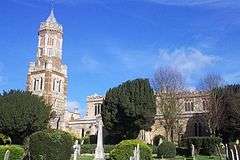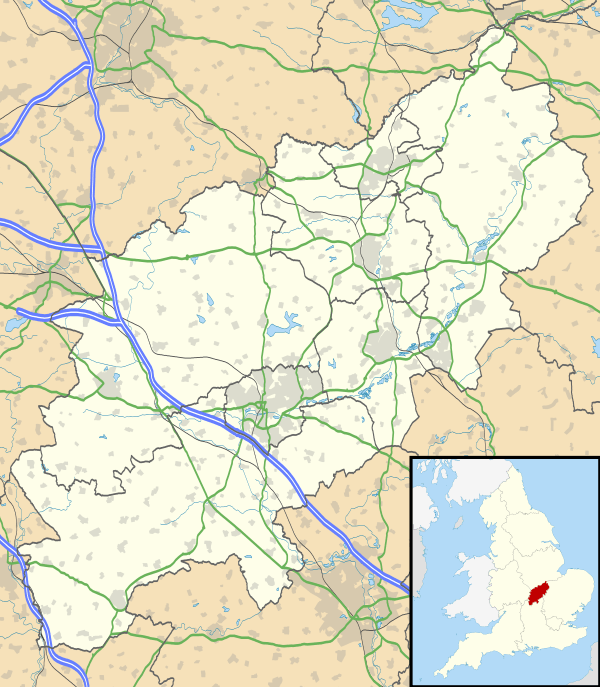Irthlingborough
| Irthlingborough | |
 St Peter's Church, Irthlingborough |
|
 Irthlingborough |
|
| Population | 8,900 [1] (2011 Census) |
|---|---|
| OS grid reference | SP945705 |
| District | East Northamptonshire |
| Shire county | Northamptonshire |
| Region | East Midlands |
| Country | England |
| Sovereign state | United Kingdom |
| Post town | WELLINGBOROUGH |
| Postcode district | NN9 |
| Dialling code | 01933 |
| Police | Northamptonshire |
| Fire | Northamptonshire |
| Ambulance | East Midlands |
| EU Parliament | East Midlands |
| UK Parliament | Corby |
|
|
Coordinates: 52°19′26″N 0°36′50″W / 52.324°N 0.614°W
Irthlingborough /ˈɜːrθlɪŋbərə/, is a town on the River Nene in Northamptonshire, England. It had a population of 8,535 at the 2011 census[1] and is the smallest town in England to have had a Football League team, Rushden & Diamonds F.C. The parish church, St Peter, has a lantern tower, unusual for Northamptonshire churches, which was built to guide travellers across the Nene valley in foggy weather. It also has doors at the four cardinal points; of note are the eight misericords in the chancel.
History
Irthlingborough was called Yrtlingaburg in the 8th century,[2] Erdiburn in the Domesday Book, and later Artleborough.[3]
Offa's Parliament
King Offa of Mercia held court near Irthlingborough circa 790.[4]
John Pyel
In 1375 John Pyel, Mayor of London in 1372 - who is believed to have been born at Irthlingborough circa 1310 - obtained a royal licence to found the college of St. Peter, Irthlingborough by upgrading the parish church of St Peter. The college was to have six secular canons — one a dean — and four clerks, but he died before his intention was actually carried out. The design was eventually accomplished by his widow, Joan, in 1388.[5]
Mining
In the past ironstone was mined near Irthlingborough, and as part of the local ironstone mine, a tunnel was bored between Irthlingborough and nearby Finedon. The tunnel still exists, although the Irthlingborough end has been landscaped over and the Finedon end sealed with concrete. Irthlingborough railway station closed in 1964 to passengers.
Quarrying
More recently the River Nene floodplains located between the town and its neighbour, Higham Ferrers, have been quarried for gravel. Quarrying in the area was extensive, stretching to Northampton in the west (upstream) and Thorpe Waterville in the north-northeast (downstream). The quarries were later left to fill with water creating man-made lakes. In 2012 the area was acquired by The Wildlife Trust, and has since been turned into Irthlingborough Lakes and Meadows, a Nature Reserve.[6] It will forms part of the Upper Nene Valley Special Protection Area.[7]
Geography
The town can be divided quite easily into areas with Pine Trees to the south-west, Victoria and Allen roads in the centre running parallel to the High Street on either side, Knightlands to the North, Crow Hill to the north-east (over a mile from the town centre) and the football ground and training facilities to the east.
The A6 used to pass through the town, but was bypassed in the 1930s to the north. The former route is the B5348. Irthlingborough Viaduct was built in 1936 and connects the town to Higham Ferrers and the busy A45. The A45 (former A605) is a more dependable road than the A6, being less twisty and with fewer tractors in the traffic.
Local economy
Whitworths, the home baking and healthy snack products company, has been based in the town since 1886 and employs 310 people at the plant on the B571 ('Wellingborough Road'). Sonifex, a manufacturer of radio broadcast products, has been in the town since its beginning in 1969 and has its research and manufacturing base on Station Road. Dr. Martens has a long history with the town; the manufacturer R. Griggs, owned by Max Griggs, had its head office in the town until production moved to China in 2003, much to the displeasure of the National Union of Knitwear, Footwear & Apparel Trades. In 2003 the company made a loss of £60m, having lost £32m in 2002. The company's office is now in Wollaston. The Wellingborough factory was the first to close in July 2002.
Education
There is an infant and junior school and one secondary school Huxlow Science College which has a sixth form part of the east Northamptonshire sixth form college
Sport
Between 2001 and 2006 Irthlingborough held the distinction of being the smallest town to hold a football league club when Rushden & Diamonds F.C. were promoted to League 2 (Then known as Division 3) after winning the 2000-01 Football Conference title. This was in part due to the funding of local businessman Max Griggs who bankrolled the club in the late 90's until the mid Millenium when he sold to a fans group for just £1 in 2005. The club were relegated from the football league in 2006 and went out of business in 2011 due to severe financial problems.
References
- 1 2 Archived 29 June 2011 at the Wayback Machine.
- ↑ Oxford Dictionary of British Place Names, Oxford University Press, 2003, ISBN 978-0198527589,
- ↑ A History of the County of Northamptonshire, Vol. 3, William Page (ed.), Victoria County History, 1930. p.207
- ↑ "Charter". Nationalarchives.gov.uk. Retrieved 2015-05-01.
- ↑ The College of Irthlingborough: A History of the County of Northampton: Volume 2, R.M. Serjeantson, W.R.D. Adkins (editors), 1906.
- ↑
- ↑ Archived 6 March 2012 at the Wayback Machine.
External links
- Irthlingborough Historical Society
- A History of Irthlingborough Iron Ore Mine.(for Laptops & Desktops)
- A History of Irthlingborough Iron Ore Mine.(for Mobiles)
- Parish Church of St Peter, Irthlingborough
- BBC page
- 1st Irthlingborough Scout Group